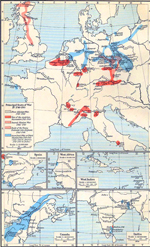|

Bonnie Prince Charlie 1720-1788
Bonnie Prince Charlie was the nickname of
Charles
Edward Louis Philip Casimir Stuart and his soup was usually cold by the time his mother was done calling him for dinner.
People also called him the
Young
Chevalier, or the Young Pretender.
Stuart, by the way, can
also be spelled Stewart.
|
|
Image above:
Prince Charles
Edward Stuart, 1732, oil on canvas, by Antonio
David
Scottish National
Portrait Gallery |
Bonnie Prince
Charlie's Family
Charles Edward's father was
James Edward Stuart, also called
the Old Pretender.
Charles Edward's mother was
Maria Clementina Stuart, nee Sobieska.
Charles Edward's brother was
Henry Stuart, who became
Cardinal Duke of York.
Bonnie Prince
Charlie and the Throne
Being a member of the royal
 Stuart
family, Charles Edward too claimed the British throne.
Stuart
family, Charles Edward too claimed the British throne.
Trouble was, his grandfather,
 James II, had been exiled and
replaced by
James II, had been exiled and
replaced by
 William
III and William
III and
 Mary II in 1689, at which point
Bonnie Prince Charlie lost his ticket to the throne.
Mary II in 1689, at which point
Bonnie Prince Charlie lost his ticket to the throne.
Why did James II have to go?
Because he was too Catholic for the
British. But his family was not completely cut off from ruling.
Mary II, a Protestant, was his daughter.
Mary II died in 1694. After William
III's death in 1702, it was Mary's sister
 Anne who became queen.
Anne who became queen.
Next in line would have been
Sophia, granddaughter of
 King James I. But Sophia
died two months before Queen Anne died. This made Sophia's son,
George Louis, the next ruler. He became
King George I, ruled from 1714 to 1727, and was followed
by his son, George II, who ruled
1727 to 1760. Next on the throne was George II's grandson
George III, who ruled 1760 to
1820.
King James I. But Sophia
died two months before Queen Anne died. This made Sophia's son,
George Louis, the next ruler. He became
King George I, ruled from 1714 to 1727, and was followed
by his son, George II, who ruled
1727 to 1760. Next on the throne was George II's grandson
George III, who ruled 1760 to
1820.
See also
 Governments of Great Britain.
Governments of Great Britain.
This was Bonnie Prince Charlie's
background. How did Bonnie Prince Charlie fit in?
Not at all. And that was his problem.

BONNIE PRINCE CHARLIE
1720 - 1788
Bonnie Prince
Charlie and the Jacobite Rebellion
In the midst of the
 War of the Austrian Succession,
Bonnie Prince Charlie came over from mainland Europe and landed in
Scotland in July 1945. His intention was to fight his way all the way
south to
London and onto the throne.
War of the Austrian Succession,
Bonnie Prince Charlie came over from mainland Europe and landed in
Scotland in July 1945. His intention was to fight his way all the way
south to
London and onto the throne.
His revolt was called the
Jacobite
Rebellion, which proved unsuccessful because of a lack of
a sufficient number of supporters.
The Jacobite
Rebellion was fought 1745 and 1746 and is not to be mixed up with
the
 Jacobite War. Jacobite War.
About the
Jacobites
Is the Jacobite Rebellion in any way
related to the Jacobite War?
Yes, it is.
The Jacobites were in support of the
restoration of the exiled King James II. When James II died, this
group was not discouraged and kept fighting for the restoration of
his heirs, Bonnie Prince Charlie being one of them.
James is Jacobus when
you say it in Latin.
BATTLE OF CULLODEN - April 16, 1746
April 16, 1746 - one of Charlie's darker days. At Culloden Moor,
about 6 miles or 10 kilometers east of Inverness, Charles met with
William Augustus, who was the duke of Cumberland, for a 40
minute battle. Big victory for the Cumberland team.
Bonnie Prince Charlie and his Jacobites had an army of
5,000 troops. William Augustus and the British Redcoats had an army
of 9,000 troops. Charlie lost 1,000 men, William 50.
By the way, it is perfectly legit to
call the Battle of Culloden the Battle of Drummossie,
because Colloden Moor is part of Drummossie Moor.
The Battle of Culloden was the last
battle of the Forty-five Rebellion or the
Jacobite
Rebellion.
With the help of Flora Macdonald
and other loyal friends, Charles managed to save his hide and escape
to France. That was in September 1746.
Bonnie Prince
Charlie's Later Years
Bonnie Prince Charlie went back to
Europe, and, because he was still a Catholic, as close to Rome as
possible.
He loved himself a
good pint and, perhaps not completely unrelated to this preference, became Scotland's hero.
And here is a map of Charlie's Raid into England 1745-1746

Map of
Bonnie Prince Charlie's Raid into England 1745-1746

Map of
the British Isles: Route of the Young Pretender (1745)
More History
|